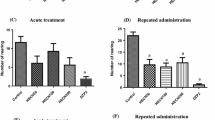Objective. To study the antidepressant activity of original Russian derivatives of 3-hydroxypyridine and succinic acid (emoxypine, Reamberin, and Mexidol) in experiments on rats. Materials and methods. The effects of emoxypine, Reamberin, and Mexidol on the duration of “despair behavior” were studied in rats in the Porsolt forced swimming test. The effects of study drugs on the animals’ behavior in the open field test were also studied. Amitriptyline and α-lipoic acid were used as reference agents. Results and conclusions. Three optimum doses of each of the study drugs, corresponding to the therapeutic range in humans, were found to decrease the duration of despair behavior in the Porsolt test. This effect of emoxypine, Reamberin, Mexidol, and α-lipoic acid provide evidence of their antidepressant activity, the extent of which depended on the actions of the study drugs in the open field. Reamberin and α-lipoic acid, the maximal doses of which either had no effect on orientational activity in the open field (Reamberin) or suppressed it (α-lipoic acid), were no less active than amitriptyline in terms of the extent of the antidepressant effect. 3-Hydroxypyridine derivatives (emoxypine and Mexidol), which had stimulatory actions on activity in the open field test, were significantly less active than amitriptyline in decreasing the duration of despair behavior.
Similar content being viewed by others
References
L. N. Semchenko, T. V. Drozdova, and M. N. Zinov’eva, “Use of Mexidol for the treatment of animals with chronic cerebrovascular failure with vestibulocochlear manifestations,” Byull. Eksperim. Biol. Med., Suppl. 1, 75–77 (2006).
I. A. Volchegorskii, M. G. Moskvicheva, and E. N. Chashchina, “Effects of emoxypine, Reamberin, and Mexidol on neuropathic symptomatology and left ventricular myocardial systolic function in patients with diabetes mellitus and diabetic foot syndrome,” Ter. Arkh., 77, No. 10, 10–15 (2005).
I. A. Volchegorskii and K. M. Mester, “Effects of 3-hydroxypyridine and succinic acid derivatives on the dynamics of vertebroneurological symptomatology after removal of intervertebral disk hernias,” Zh. Nevrol. Psikhiat., 110, No. 3, 19–24 (2010).
O. V. Kashichkina and N. A. Kriger, “Therapeutic efficacy of Mexidol in the treatment of alcohol withdrawal syndrome,” Byull. Eksperim. Biol. Med., Suppl. 1, 167–171 (2006).
I. A. Volchegorskii, P. N. Novoselov, and T. V. Astakhova, “Effects of ascorbic acid and emoxypine on the efficacy of complex chemotherapy of infiltrating pulmonary tuberculosis,” Ter. Arkh., 81, No. 11, 21–24 (2009).
I. A. Volchegorskii, E. V. Tur, O. V. Solyannikova, et al., “Efficacy of 3-hydroxypyridine and succinic acid derivatives in the complex treatment of primary open-angle glaucoma,” Eksper. Klin. Farmakol., 75, No. 7, 20–26 (2012).
K. M. Dyumaev, T. A. Voronina, and L. D. Smirnov, Antioxidants in the Prophylaxis and Treatment of CNS Pathology, Institute of Biomedical Chemistry, Russian Academy of Medical Sciences (1995).
T. A. Voronina, “Mexidol: spectrum of pharmacological effects,” Zh. Nevrol. Psikhiat., 112, No. 12, 86–90 (2012).
E. E. Fufaev and A. N. Tulupov, “The detoxifying and antioxidant activities of Reamberin in the complex treatment of acute infectious destruction of the lungs,” Khirurgiya, No. 4, 43–47 (2012).
I. A. Volchegorskii, M. G. Moskvicheva, and E. H. Chashchina, “Effects of antioxidants on the signs of sensorimotor polyneuropathy and affective impairments in diabetes mellitus,” Zh. Nevrol. Psikhiat., 105, No. 2, 41–45 (2005).
I. A. Volchegorskii and N. V. Mester, “Effects of antioxidants of the 3-hydroxypyridine group on depression in patients with diabetes mellitus,” Klin. Med., 85, No. 2, 40–45 (2007).
E. V. Kovaleva, L. L. Prilipko, K. O. Muranov, and V. E. Kagan, “Effects of antidepressants on 3H-serotonin release by rat brain synaptosomes,” Byull. Eksperim. Biol. Med., 96, No. 10, 55–57 (1983).
E. S. Kurasov and R. S. Remizevich, “Effects of Mexidol on sleep impairments in combination with antidepressant treatment in panic disorder in young patients,” Zh. Nevrol. Psikhiat., 113, No. 2, 33–38 (2013).
R. A. Kopaladze, “Regulation of animal experiments – ethics, law, and alternatives,” Usp. Fiziol. Nauk., 29, No. 4, 74–92 (1998).
J. J. Buccafusco, Methods of Behavioral Analysis in Neuroscience, CRC Press LLC, London, New York (2009).
I. A. Volchegorskii, I. I. Dolgushin, O. L. Kolesnikov, and V. E. Tseilikman, Experimental Modeling and Laboratory Evaluation of the Adaptive Responses of Organisms, Chelyabinsk State Pedagogical University Press, Chelyabinsk (2000).
I. A. Volchegorskii, L. M. Rassokhina, and I. Yu. Miroshnichenko, “Antioxidants in experimental diabetes mellitus,” Prob. Endokrinol., 54, No. 5, 43–49 (2008).
I. A. Volchegorskii, L. M. Rassokhina, and I. Yu. Miroshnichenko, “The insulin-potentiating actions of antioxidants in experimental diabetes mellitus,” Prob. Endokrinol., 56, No. 2, 27–35 (2010).
R. D. Porsolt, G. Anton, N. Blavet, and M. Jalfre, “Behavioural despair in rats: a new model sensitive to antidepressant treatments,” Eur. J. Pharmacol., 47, 379–391 (1978).
I. A. Volchegorskii, L. M. Rassokhina, and I. Yu. Miroshnichenko, “Effects of pro- and antioxidants on insulin sensitivity and glucose tolerance,” Byull. Eksperim. Biol. Med., No. 9, 295–301 (2010).
Author information
Authors and Affiliations
Corresponding author
Additional information
Translated from Zhurnal Nevrologii i Psikhiatrii imeni S. S. Korsakova, Vol. 115, No. 2, Iss. 1, pp. 48–52, February, 2015.
Rights and permissions
About this article
Cite this article
Volchegorskii, I.A., Miroshnichenko, I.Y., Rassokhina, L.M. et al. The Antidepressant Actions of 3-Hydroxypyridine and Succinic Acid Derivatives in Experimental Studies. Neurosci Behav Physi 46, 677–681 (2016). https://doi.org/10.1007/s11055-016-0296-8
Published:
Issue Date:
DOI: https://doi.org/10.1007/s11055-016-0296-8



